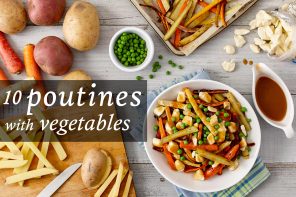To help you diversify your menu, Arctic Gardens has created several recipes around vegetable protein. We rarely think about plants when we’re planning meals. They’re entirely natural and come from the earth, have nutritional benefits and brighten up our dishes. Thanks to vegetable protein, we’ve got all kinds of food preparations available to us!
Legumes: The All-Purpose Food

When preparing a vegetarian meal, we often turn towards legumes to top up protein requirements. As well as being an excellent source of vegetable protein, legumes are rich in carbohydrates and fiber. They satisfy hunger, so there are no more excuses for snacking between meals!
As well, with dozens of varieties available on the market, dishes can be varied easily with legumes! Lentils, chick peas and beans are the most consumed legumes.
| 100 g raw lentils | 26 g of protein |
| 100 g raw chick peas | 19 g of protein |
| 100 g cooked white beans | 9.7 g of protein |
Why We Love Legumes
We love legumes because they’re versatile. They can be added to all kinds of recipes: soups, dips and even desserts. You don’t have to spend more than a dollar or two for a can! These are all good reasons to add legumes to your diet.
How Do You Cook Legumes?
Legumes have several uses in cooking. They can be slipped into many dishes: salads, stews, sandwiches, etc. They can also be substituted for some ingredients. Instead of making mashed potatoes, make mashed white beans. Legumes are sometimes the heart of the recipe. Can you imagine a chili without kidney beans? They can also be eaten as a snack. Chick peas roasted in the oven with a few spices will satisfy your salty cravings!
Don’t forget to rinse legumes before using. Dry and canned legumes alike must always be rinsed. For a quick preparation, choose canned legumes. They’re already cooked!
Nuts: An Excellent Source of Energy

The word “nuts” is generally use to describe hazelnuts, almonds, nuts and other pistachios as a group. From a nutritional standpoint, nuts are an interesting source of plant protein. They give you a boost of energy, as well as satisfy hunger.
| 100 g dry almonds | 21.3 g of protein |
| 100 g dry hazelnuts | 15.2 g of protein |
| 100 g dry nuts | 15 g of protein |
Why We’re Nuts About Nuts
We love them because they have good fat (mono-unsaturated and poly-unsaturated) which help lower blood cholesterol levels. Some nuts like walnuts also contain omega 3. Nuts are definitely excellent for your health!
How Do You Cook Nuts?
People love using nuts in cooking because they can be added to sweet dishes like banana bread and chocolate brownies. Of course, they can be added to main dishes, too, and are often found in stir-fries or a veggie hash. A serving of nuts (about 30 g) can also be enjoyed as a snack. Explore transformed products like nut butter or almond milk.
Grains: A Surprising Source of Protein

Grains are found almost everywhere: in pasta, bread, pancakes, etc. Among others, wheat, rice and oat come to mind. There is a similar grain category; in other words, pseudo grains. Quinoa and buckwheat are part of that family, but what is a pseudo grain? It’s a grain plant very close to grains, but that aren’t part of the grass or graminaceous family.
Grains and pseudo grains are sources of plant protein that we don’t always think about. There is less chance of forgetting about them now because they provide enough protein, are rich in fiber and complex carbohydrates!
| 100 g oat flakes | 17 g of protein |
| 100 g whole wheat flour | 13.5 g of protein |
| 100 g cooked quinoa | 13 g of protein |
| 100 g buckwheat flour | 12.5 g of protein |
Why We Love Grains
We love grains because they can be added to just about anything. You can eat them for breakfast as much as supper. Grains are very versatile because they can be easily transformed into flour. They’re present in so many products that you consume them without even thinking about it! So you don’t have to change your eating habits.
How Do You Cook Grains?
Wheat flour or oat flakes are often used in cooking. These ingredients can be found in a number of recipes. Wheat flour is the base of any cake or pancake. To satisfy your craving for dessert, healthy oat cookies will work just fine! You can also make homemade granola to put in yoghurt.
Pseudo grains can be used in several ways. Everyone knows that buckwheat flour makes delicious pancakes smothered in molasses. Quinoa is great in a cold or hot salad. It can replace traditional rice or couscous dishes and is made the same way. For a great quinoa, season with fine herbs and a little olive oil and voilà!
Tofu: A True Chameleon

Tofu is the best known substitute for vegetarian dishes, but what is it exactly? It’s a food that’s made from soy beans and it provides enough protein while being low in calories!
| 100 g of firm tofu | 14 g of protein |
Why We Love Tofu
We love tofu because it’s healthy. Some people would say that we also love it because it absorbs the flavour of whatever it is you cook with it. It’s true. Tofu can be really delicious, but it can take some effort to cook with it. The main reason we love it is because it’s just plain good for you.
How Do You Cook Tofu?
There are many ways to cook tofu. Silken tofu which is less consistent than other kinds can be hidden in smoothies or mousses. It can also replace eggs in many desserts. Extra firm tofu is easy to marinate and grill. Because it’s firm, it won’t fall apart when you cook it. Crumbled, extra firm tofu has the same texture as ground meat. The consistency of firm tofu is between extra firm and silken which can be used easily in chili and tacos.
Emerging Vegetable Protein
Some food that is rich in vegetable protein is less well known, but it’s still making a name for itself in our diet.
Seaweed: An Asian Inspiration

Seaweed is commonly eaten in the East. However, it’s still not very popular in North America where we use it only for sushi. Sheets of nori are used to make sushi. Nori seaweed has close to 30 % more protein than meat and 10 times more calcium than milk. That’s why professional chefs are saying that seaweed is the food trend this year. With its numerous nutritional virtues, seaweed is the trend that you want to watch!
| 100 g dry nori | 36 g of protein |
Tempeh: The Newcomer

Tempeh resembles tofu and is also made from soy. The only difference is that, in the case of tempeh, the soy is fermented. Its nutritional profile is pretty impressive, too. Tempeh has more vitamins, fiber and protein than tofu! In terms of preparation, it can be fried or be cooked exactly like tofu.
| 100 g tempeh | 19 g of protein |
When planning your menu for the week, keep in mind the different vegetable protein options that are available to you!
Our Recipes with Vegetable Protein
Discover our recipes specifically created around vegetable protein that are sure to revitalize your menu! You’ll find dishes with tofu and legumes as the base. Some recipes showcase nut spreads and grains. There is a lot to choose from!
Mexican Quinoa Salad

Number of servings: 6
Preparation time: 15 minutes
Cooking time: 2 minutes
With pieces of avocado and fine herbs, this cold quinoa salad is really fresh. It can also be served as a side to a main. The quinoa and black beans give this dish enough protein to satisfy your appetite!
Thai Red Lentil Soup

Number of servings: 4 to 6
Preparation time: 10 minutes
Cooking time: 25 minutes
This red lentil soup recipe will whisk you away! Coconut milk and curry paste are reminiscent of the flavours in Thai cuisine. Red lentils complete this dish perfectly. This Thai recipe will become your favourite soup-as-supper meal!
Veggie Burger

Number of servings: 4 to 6
Preparation time: 20 minutes
Cooking time: 40 minutes
These veggie burgers reinvent traditional ones and they’re also just as nourishing as meat burgers. Crushed white beans recreate the texture of ground meat just beautifully. As well, the patty in this recipe contains an additional serving of veggies. Once barbecue season arrives, try this recipe this summer!
Crispy Tofu with Peanut Sauce

Number of servings: 4
Preparation time: 15 minutes
Cooking time: 10 minutes
If you usually have trouble seasoning tofu, this recipe is the solution. The magic ingredient is the peanut sauce which adds a touch of sweetness to the tofu. When cooked this way, you can’t help but fall in love with grilled tofu!
Honey and Vegetable Cakes

Number of servings: 24
Preparation time: 15 minutes
Cooking time: 25 minutes
This dessert will give you a boost of energy – and yes, it’s a protein dessert! Thanks to the walnuts, there are almost three grams of protein in each cake. Hidden inside these little cookies is a serving of veggies. You can also store this dessert in an airtight container, so you’ll always have a few cakes on hand!
Vegetable protein is an excellent alternative to the usual meat dishes. Thanks to our tricks, you’re now sufficiently equipped to cook all sorts of meatless dishes. Start by gradually integrating vegetable protein into your recipes and see how your dishes are totally transform! What source of vegetable protein will you add to your diet?









